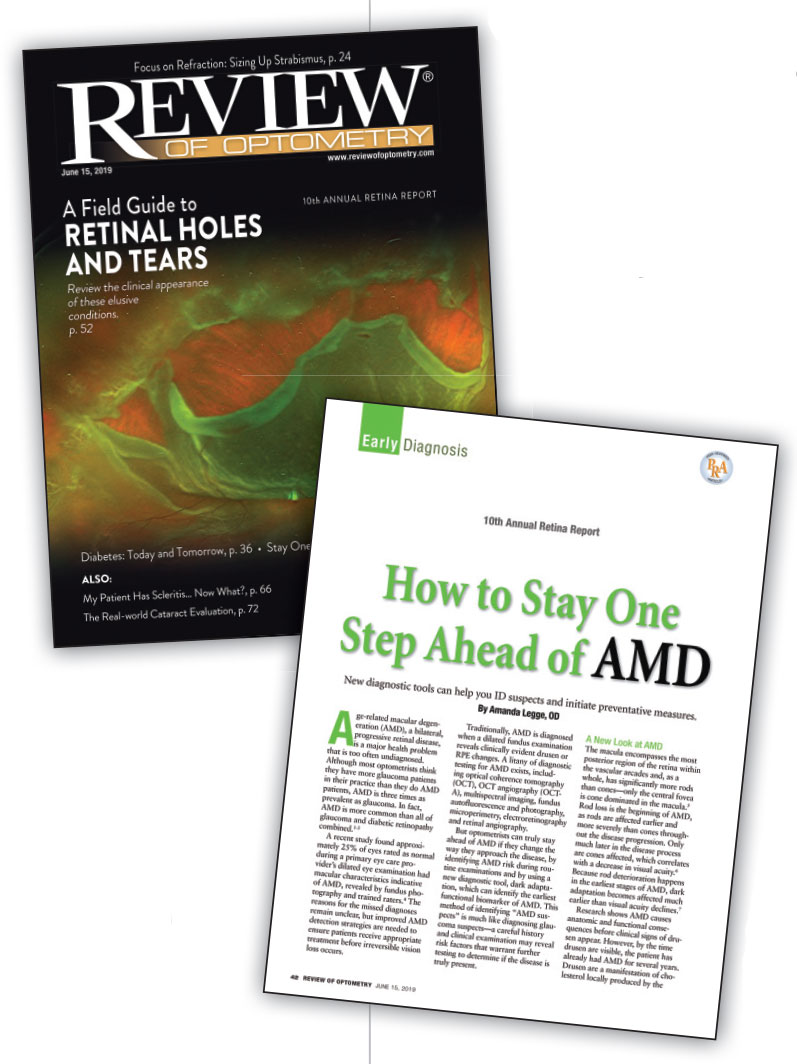Keep Visual Function in Sight
The 10th Annual Retina Report published in the June 15, 2019, issue includes another excellent medical article on age-related macular degeneration, “How to Stay One Step Ahead of AMD.” However, it is another example of how far optometry has strayed from its original foundation in vision care.
As optometrists, we must remember that all of the new technology for diagnosis and management we use, the nutritional and lifestyle changes the patient must make, the office visits, tests and injections into the eye they must endure are all done and suffered through for one reason: they want to see!
 |
In a discussion with Henry Greene, OD, President of Ocutech, we reminded each other of the benefits of medical optometry. In the early days of our careers (1970s and 1980s), virtually all of our low vision patients had less than 20/400 vision. In fact, I hardly saw any wet AMD patients due to such poor acuity. Nowadays, nearly all of our patients are between 20/70 and 20/200, with much better results achieved with low vision care.
The point is this: it is still vision loss. We are still in the business of making people see to function.
In my opinion, every article on AMD must remind optometrists that referral to low vision rehabilitation is now the standard of care for those facing vision loss. Thank you for your consideration.
—Richard J. Shuldiner, OD, FAAO, FIALVS
President, International Academy of Low Vision Specialists
Clinical Director, Low Vision Optometry of Southern California
Dr. Legge replies: Dr. Shuldiner’s point is well taken. We have a low vision specialist within our own office and I have been tending to send patients with AMD or other eye diseases for a consult earlier and earlier. Even patients with best-corrected vision of 20/30 or 20/40 can benefit from certain devices or specialty spectacles, depending on their visual demands.
That said, the intention of my article was more geared toward early diagnosis, intervention and prevention of vision loss rather than managing patients throughout a progressive AMD diagnosis and vision deterioration.
Editor’s note: Low vision is indeed a vital part of optometrists’ efforts to restore as much functional vision as possible. Recognizing its importance, we have included in this month’s issue a feature article devoted to some of the latest advances in the field.
The complexity of AMD also warrants the inclusion of articles limited in scope to a particular aspect, such as diagnosis, so that the topic can be discussed in depth. Early disease recognition and intervention holds the potential to forestall the vision loss itself, perhaps preventing or delaying the need for low vision interventions or improving the uncorrected acuities of patients so that they may have an easier time incorporating visual aids into their lives.
Rethinking an Old Therapy
I think we sometimes overlook possible treatments that are right in front of us. I was in practice for 30 years and only had five cases of epidemic keratoconjunctivitis. All of these were treated with apparent success. I used 5% NaCl salve every two hours, positioned a half-inch in the lower cul-de-sac. I demonstrated proper instillation to the patient and instructed them to close the eye for five minutes to allow the salve to melt. In each case, it worked in about three days with no recurrence.
I think, if I am correct, routine adoption of this technique would be a better treatment for the patient than pharmaceutical use, as it would spare the patient both cost and potential toxicity to the tissue.
— John Conrad, OD, Salem, OH

